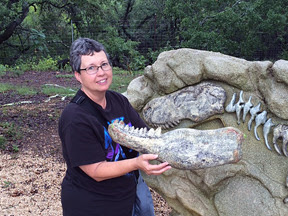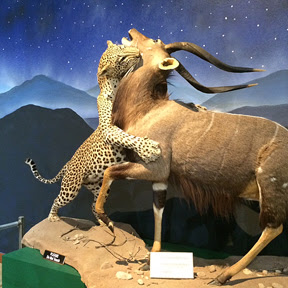We have had day after
day after day of rain. Not hard rain,
just a good soaking rain. After sitting
in the house for a week we decided we really needed to get out and do something. I Googled things to do in the Bandera area
and got a hit on two museums. One we
have been planning on visiting but had never gotten to and one we had never
heard of.
The Bandera Museum of
Natural History sounded interesting and we were somewhat puzzled that we didn’t
know it was here.
Bandera (Spanish for
flag) is a small town (population almost 1000) about 20 miles from us. When the weather is nice we drive into
Bandera almost every morning. There is a
very nice 9 hole disc golf course that Mark really enjoys playing. There are lots of restaurants and we have a
few favorites.
So we plugged the
museum into the GPS and off we went.
The museum looked
brand new and it turns out that it is.
We went inside to pay the entrance fee ($10 each).
While driving in we
noticed several very large dinosaurs scattered around the grounds. Since the rain had let up we decided we had
better see the outside exhibits first before it started raining again.
The museum sits on 8
acres. I neglected to count how many life-sized,
fiberglass reproductions of dinosaurs and Ice Age animals there were.
The monster was Mark’s
favorite:
I took about 4
pictures before my camera quit working.
Yep, it’s the same camera that quit during a kayak trip in Alaska. That camera is now in the trash and a new one
is has been ordered. Mark got out his
phone and we continued the tour.
The big toe guy is a
Deinonychus (Terrible Claw).
Some of the Dinosaurs
were in Texas 70 million years ago.
These play stations
were a lot of fun! You take the bones
off the walls and bury them in the sand.
After walking around
the grounds we headed inside the 14,000 square foot museum.
The creator of the museum is 81 year old Juan Infante, an
Argentina-born mechanical engineer and big-game hunter. He’s also been a rancher in Bandera for over 40
years.
The museum initially was planned as an exotic wildlife
museum filled with the mounted figures of the animals Infante had hunted on his
many trips around the world. It ended up
being a $4 million natural history museum.
The museum’s six dioramas display some of the nearly 100
body mounts of animals Infante downed on his hunting.
Ironwood carving of
two lions on attack (this was carved from one piece of wood).
The museum is small
but is packed with lots to see. There
isn’t a lot of written information. Everything
is nice and clean and well displayed.
Before we left we
talked with one of the employees. She
told us the museum had opened about a year ago.
Now it made more sense that we hadn’t heard of it before!
It was a great way to
spend a rainy morning.
Teri
























































